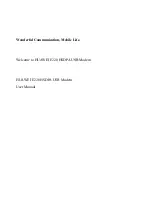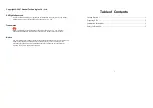
Installation
PSM-500/500L/500LT SCPC Satellite Modem
Page 2-24
PSM-500/500L/500L T- Rev. 0.91
2.9.7 Setting the Modem Address for Command Mode Operation
If Command Mode Binary Packet Operation is desired the modem packet “address” must be set
via the front panel before the modem will recognize packets. To set the address use the arrow
keys to go to the
<Unit: Remote – Address>
parameter and press “Edit”, then use the numeric
keypad to enter the address from 0 to 255. Then press the “Enter” key to enable the change.
The address 255 is “global” and all units will respond to a message packet with this address
regardless of its setting, but no unit will return a response message. It is suggested that you do
not use addresses 1 or 255 (1 is the factory setting, and any new unit added to a system will
have address 1).
The address “0” is also unique. This address causes the modem to accept commands and send
responses without the address fields normally required in the command packets.
2.10 Interface Type Configuration
The PSM-500 Modem contains on-board circuitry to implement several different interface types:
0
Disabled
1
RS-232 (Synchronous only, limited to 128 kbps by drivers and receivers)
2
RS-449
3
RS-449/Unterminated (used in redundancy)
4
V.35
5
V.36
6
EIA-530
7
EIA-530A
8
SnIP (Option)
9
HSSI (Option)
A single 37 pin female “D” type connector on the rear panel at J3 is used for all interface types.
The connector pin-out is shown in Chapter 2, Installation. Adaptor cables are available for other
physical connector types. The two we make are the DB25 (P/N DSF00-080) and Winchester M34
style V.35 (P/N DSF00-083). See Appendix C for more cabling information.
The modem is also capable of accepting one of several existing and to be implemented
additional option interfaces. These include a 10 Base T Ethernet interface, a High Speed Serial
Interface (HSSI), a G.703 interface and others. The main processor automatically determines the
presence and type of interface and options by querying the interface card. Adding an optional
interface card or changing an already installed interface should only be attempted by experienced
personnel familiar with electronic communications equipment. Either of these operations requires
removing the modem from service, and removal and replacement of the modem top cover to gain
access to the interface PCB assembly.
2.10.1 Adding or Changing the Optional Interface Type
An optional interface card may be installed or exchanged in a modem unit by removing the
modem’s top cover. First the interface option card rear panel plate is released from the chassis
by removing the two screws on either side of this plate at the rear panel. The interface card to be
removed is disconnected from the main board by releasing the one or two ribbon cables from the
IDC connectors at P5 and P7 (or P5 only if so configured). These designations are those on the
main modem PWB. The three #6 screws and lock washers are then removed if in an existing
board and saved for placing the new interface card into the chassis. Once the new interface card
is installed on the standoffs the two rear panel screws are installed first, then the three #6 screws
are used to mount the board to the chassis (some boards have 4 mounting screws). Finally the
required ribbon cables are (re-)attached to the new card and the main PWB at P5 (and also P7 if
used). Finally the unit top cover is replaced using the 8 screws removed above.
















































